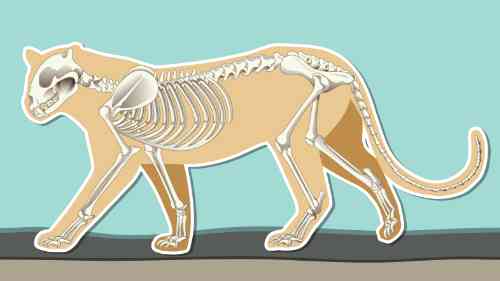Why is my cat’s tail crooked?
Can this cause problems?
You see them walking around on the street quite often. A cat with a crooked tail. This can be a very small kink up to a 90° kink. In this article we discuss how his crooked tail may have developed. We will tell you how to diagnose it and how it can be treated. And then we will also tell you what the consequences of a crooked tail in your cat can be later in life. Hopefully you will find the answers you are looking for in this article.
When are we talking about a crooked tail in a cat?
If your cat’s tail vertebrae do not form a straight line, but have a kink, then there is a crooked tail in your cat. In that case you will not see a long straight graceful tail. But in that case your cat has a tail that is clearly crooked. The crooked tail can be caused by a fracture. But it can also be a congenital or even hereditary deformity.
Anatomy of a normal tail in a cat
A cat’s normal tail vertebrae begin after the sacrum, which forms part of the pelvic canal. The first tail vertebrae after the sacrum are somewhat shorter and wider. The further the vertebrae are towards the tip of the tail, the longer and the narrower they become. You can see this in the image below. All the vertebrae of the tail normally lie in a straight line, forming a straight tail in a cat.


Causes of a crooked tail in your cat
If there is a crooked tail in your cat, he may have been born with it. As a kitten he already had a kink in his tail in that case. We call this a congenital defect in your cat’s tail. But just because your cat was born with it does not automatically mean that it is a hereditary birth defect.
A hereditary defect
A hereditary birth defect is caused by an error in his DNA. This creates a crooked tail in your cat, in this case a kitten. In Asian countries many cats have a kink in their tail. The study “Whole Genome Sequencing Identifies a Missense Mutation in HES7 Associated with Short Tails in Asian Domestic Cats” showed that the gene HES-7 may contain a mutation. This mutation can cause crooked tails or even no tails in cats. So that is a hereditary defect.
A congenital defect
But what is the difference between a congenital defect and a hereditary defect? If there is no abnormality in the kitten’s DNA, then there is no hereditary abnormality. However, the tail can, for example, become stuck in the umbilical cord, preventing his tail from developing normally. In that case, a crooked tail of a cat (kitten) may occur. Congenital defects arise in the womb, but this does not necessarily mean that an error has occurred in the DNA.
A non-congenital defect
And then of course there is also a crooked tail in a cat that occurs later in life. In most cases this occurs as a result of a broken tail. Accidents involving vehicles such as cars or bicycles are the most common reason. But it also often happens that your cat has gotten his tail stuck in the door. There may then be a broken vertebra, causing the straight line of the tail to be interrupted. Or an intervertebral disc is damaged. Both are causing a crooked tail in a cat .
Difference between a “kinked-tail” and a “crooked tail” of your cat
Although the terms are usually used interchangeably, in principle we speak of a kinked-tail when there is a hereditary congenital variant of a kink in your cat’s tail. Nowadays it is very hip to breed animals that have developed a deformity in their body. Take, for example, the flat noses of dogs and cats, the short legs or deformed ears. It can also be decided to breed with cats with a hereditary form of kinked-tail. Fortunately, it has been decided in a lot of countries that breeding of animals with a congenital hereditary defect is no longer allowed. Breeding a cat with a kinked-tail is therefore prohibited in those countries.
Diagnosis of a crooked tail in your cat
If your kitten was born with a crooked tail, there is no reason to have further examinations done. Your kitten does not need to undergo surgery to live a good life later. He will learn to manage just fine with his deformed tail. There is therefore no need for further veterinary visitis.
It is a different story if the crooked tail of your cat developed later in life. If the crooked cat’s tail is new, it is almost always painful. A fracture has occurred in the tail. The fracture may be in one of the vertebrae of the tail. But the fracture can also be in the cartilage between the tail vertebrae. Do you see a new kink in your cat’s tail? Then it is wise to take your cat to your vet. If necessary, they can take an X-ray to determine whether the fracture is in a vertebra or in the cartilage.
How to treat a crooked tail in your cat?
However, having an X-ray is almost never really necessary. Your vet can splint the tail to allow the tail to return to a straight position. Whether there is a fracture in the vertebrae or in the cartilage, it makes no difference. Very rarely, it may be necessary to have the tail straightened surgically. They usually do this with a metal plate. This is actually only possible if the break is in the part of the tail that is close to the body. The other vertebrae are too small and fragile to attach a metal plate to them.
However, it is not a large problem if your cat has a broken tail and you allow it to heal as a crooked tail in your cat. Once his tail has healed, he will no longer have any pain and your cat will learn to live with a crooked tail.
What should you take into account if your cat has a crooked tail?
However, there are a number of things you should take into account. The first is that cats communicate a lot with each other with their tails. If your cat has a severe crooked tail, he may be less able to communicate with his tail. The result may be that he gets into more fights with other cats in his environment. However, we very rarely hear this in practice, so it does not seem to play a major role. However, a study by S. Cafazzoa and E. Natoli shows the importance of the position of the tail in mutual communication in cats.
In addition, according to research done by Curt Walker, Charles J. Vierck Jr. and Louis A. Ritz are also important for your cat to maintain its balance. If your cat is a real acrobat, he may have difficulty keeping his balance, especially in the first period after the crooked tail in your cat has developed. He can fall more easily from fences, eaves and branches, with all the consequences that entails.
Breeding with a “kinked-tail” in your cat
As we mentioned earlier, breeding with a kinked-tail in your cat is not something you should aim for. It would mean that you are breeding cats that have a congenital, possibly hereditary defect that causes the kinked-tail. After all, it is important that we as humans do not “create” an entire cat population that has more difficulty keeping their balance and who can communicate less easily with neighbouring cats. Fortunately, deliberately allowing animals to be born “mutilated” because we like the way they look is no longer allowed in a lot of countries.
Does your cat have a non-congenital kink in its tail? Then you can use your cat to breed offspring. In that case, a crooked tail will not be a reason for problems during the birth of offspring. A small side note is that accidents can also result in a fracture of the pelvis. So in addition to a fracture of the tail, also a pelvic fracture. This can of course cause problems for cats during birth, as the pelvic canal may then not be properly accessible. This can result in a caesarean section in your cat.
Lola’s story: a case study
Lola’s story
Lola is a four-year-old, sterilized cat with a significant crooked tail. Her owners noticed the crooked tail when Lola was about one year old. That was the moment she fell off a roof. Since then, Lola has adapted to her life quite normally with a crooked tail. Her owner was still concerned about possible consequences later. That’s why they decided to ask our vet Nanda for advice.
Presentation:
The photos that were sent and the owner’s story show that Lola is very alert and active, with normal eating and drinking habits and no problems with other cats. Veterinarian Nanda noticed that the crooked tail in Lola’s tail formed an angle of about 45 degrees, about halfway down the tail. According to the owner, there was no sign of pain or discomfort when touching or moving the tail.
Probable diagnosis:
Veterinarian Nanda explained that Lola’s crooked tail was likely the result of a fracture in a tail vertebra halfway down her tail, caused by the earlier accident. Because Lola is no longer in pain, veterinarian Nanda advised not to have any further examination in the form of an X-ray, as the crooked tail had now grown solid and cannot be easily corrected by a veterinarian. There are no signs of further health problems or problems interacting with other cats and therefore no need for further treatment.
Treatment and Management:
Given the situation, and the fact that Lola had adapted well to her crooked tail, veterinarian Nanda advised not to have any treatment performed. The only option available would be to anaesthetise Lola and break her tail again to have it fixed in the correct position. Since Lola is not bothered by the kink in her tail and there are no structural problems with neighbouring cats, the operation is too intense for the profit it will yield. Not to mention the costs associated with such an operation. Lola’s owner agrees and is happy that Lola can still live a long and problem-free life with her crooked tail.
Good luck to your cat with a crooked tail!
Hopefully your cat will not be bothered by the crooked tail and your cat will also be able to have an almost normal life. Good luck!




